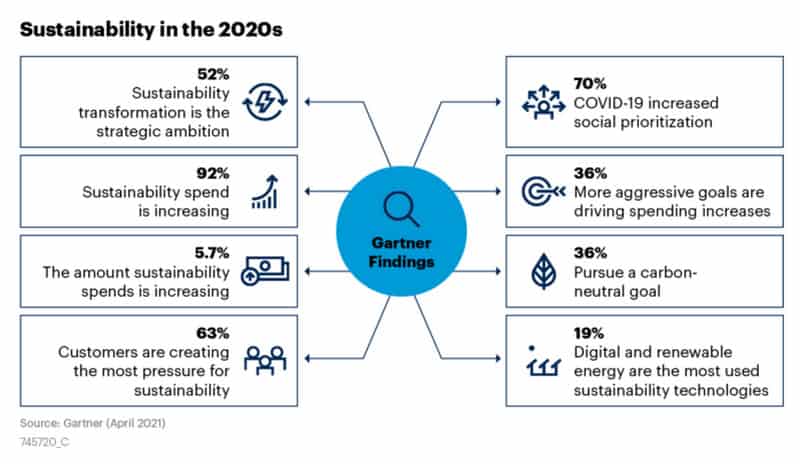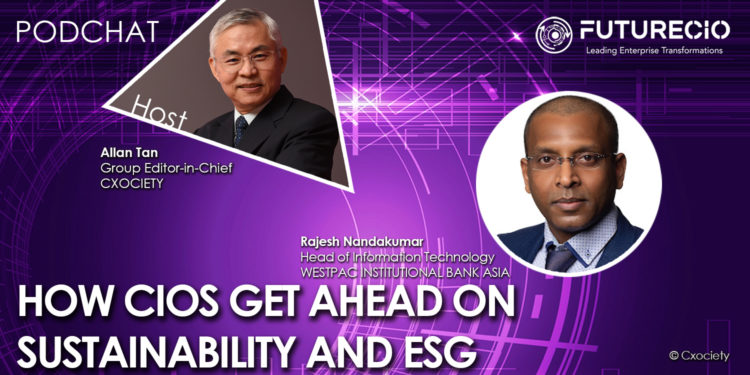The 2021 Gartner CEO Survey: The Year of Rebuilding revealed that social responsibility and ESG mentions in top business priorities have almost doubled year over year. ESG goals are becoming more aggressive, business investments are increasing, and consumers, employees and regulators are driving most of the change.

At the 2022 FutureCFO vSummit series held across Hong Kong, Indonesia, Malaysia, Singapore, and the Philippines, one topic that stood out as a point of interest for many of the participating senior finance leaders was the organisations’ commitment to sustainability goals.
But what about the head of technology? According to Gartner, there is an opportunity for the CIO to take a lead role in addressing this demand.
“Digital sustainability uses information and technology (I&T) to enable ESG transparency, automation, accuracy, and traceability. Sustainable technology is a framework to improve ESG. CIOs should lead digital sustainability (IT), amplify sustainable technology (OT) and integrate IT and OT.”
Gartner
Rajesh Nandakumar, head of Information technology at Westpac Institutional Bank Asia, says “Current environmental changes have an impact on how an economy grows. How do we continue to develop with all these changes around the world?”
He observed that the connectivity society and businesses enjoy generates zettabytes of data that must be stored and accessed from somewhere – usually the data centre. He acknowledged that data centres today account for a large portion of IT budgets.

As CIOs (these days), we need to be aware of how we can operate our data centre more energy efficient. As governments commit to achieving zero carbon footprints in the future, regulators are expecting businesses to make the effort to participate in these goals.
“As CIOs, it’s very important to keep a watch on how I manage my (IT) estate – to make sure it is compliant. We need to use technology to enable the business to meet its ESG commitments.”
Rajesh Nandakumar
To what extent is the CIO accountable for ESG's success or failure?
Rajesh Nandakumar: Today, everything is technology-driven, and all our actions are an integral part of the system. The principles to promote fairness, ethics, accountability, and transparency (FEAT) by the Monetary Authority of Singapore (MAS) can be used as guidelines. Based on these principles, the CIO is 100% accountable for ESG’s success or failure.
What are the challenges that a CIO must overcome to ensure IT can make a positive contribution to successful ESG?
Rajesh Nandakumar: It is important to create awareness within the organisation and team, and understand that ESG is still evolving. We tend to be compliant with the existing expectations or regulations because we are accountable. But organisations can introduce policies on their own or enforce ESG as one of the key performance indicators for better assessment of performance and investments.
How can CIOs get ahead on sustainability and ESG?
Rajesh Nandakumar: Prioritise ESG goals that are relevant to your domain, so you are confident in promoting and driving those goals. Make sure you have partners or colleagues with the same vision on board working on these goals. Also, continue to watch what your peers are doing and be well-informed about the latest ESG trends. Having an ESG portfolio or stories will give you an edge over other organisations.
Click on the PodChat player and hear Nandakumar share strategies to enable and empower the CIO to fulfil an organisation’s sustainable and ESG ambitions.
- How is ESG connected to IT (function)?
- What is expected of the CIO when it comes to ESG?
- To what extent is the CIO accountable for ESG's success or failure?
- What are the challenges that a CIO must overcome to ensure IT can make a positive contribution to successful ESG?
- How can CIOs get ahead on sustainability and ESG?





